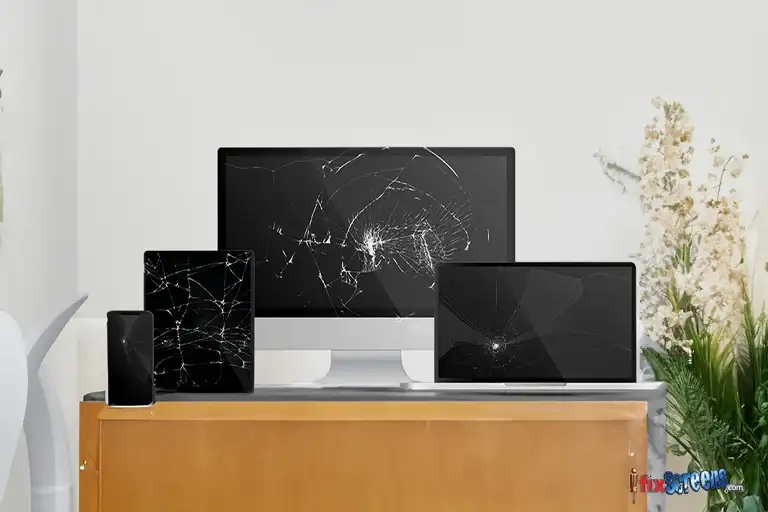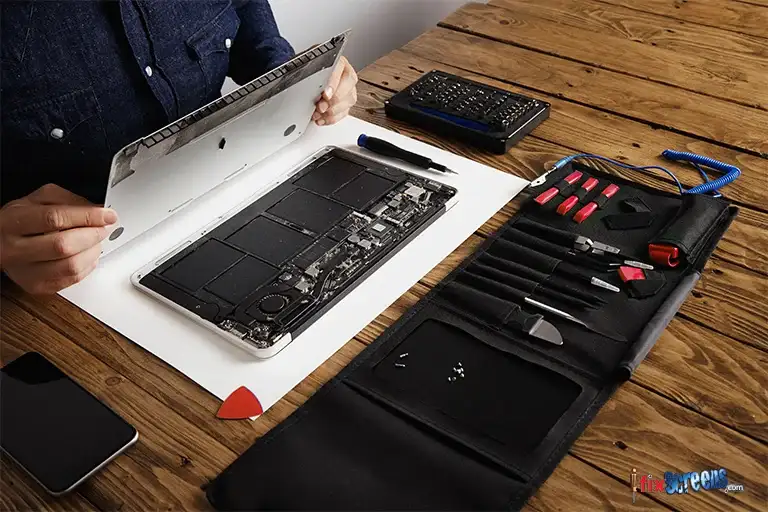Fixing Broken Screens: A Comprehensive Guide to Screen Repairs
Key Takeaways
- The inevitability of screen damage
- Understanding the nature of screen damage
- The diverse causes of screen damage
- Cracks, digitizer issues, and internal damage
- Essential tools for a successful screen repair

Fix It Right: A Comprehensive Guide to Repairing Broken Screens
In a world dominated by screens, it's almost inevitable that you'll face the dreaded moment when your device's screen breaks. Whether it's your beloved iPad, iPhone, or any other gadget, this guide will take you through the ins and outs of fixing a broken screen, helping you regain the pristine display you once had.
The Basics of a Broken Screen
Before delving into the nitty-gritty of repair, let's understand the basics. A broken screen can manifest in various ways, from minor cracks to shattered glass and unresponsive touchscreens. The causes are just as diverse, so diagnosing the issue correctly is essential.
What Causes a Screen to Break?
Screens can break for numerous reasons, including accidental drops, impacts, pressure, and manufacturing defects. Understanding the root cause of the damage can help determine the most effective repair approach.
Types of Screen Damage

Cracks: These are often superficial and can be either minor or extensive, affecting the overall usability.
Digitizer Issues: Problems with the touchscreen's functionality, such as unresponsive areas or erratic touches.
Internal Damage involves damage to the LCD or OLED display beneath the glass.
DIY vs. Professional Repair
When it comes to fixing a broken screen, you have two main options: the do-it-yourself (DIY) route or seeking professional assistance. Each approach has its merits and drawbacks.
Pros and Cons of DIY Screen Repair
Benefits of DIY Screen Repair
Cost-Effective: DIY repairs can save you money compared to professional services.
Empowerment: Learning to repair your device gives you a sense of accomplishment.
Convenience: Fix your screen on your own schedule without waiting for an appointment.
Challenges of DIY Screen Repair
Skill and Knowledge: DIY repairs require technical know-how and a steady hand.
Risk: DIY repairs can further damage your device if not done correctly.
Warranty Void: Self-repair may void the manufacturer's warranty.
Benefits of Professional Screen Repair
Expertise: Professionals have experience and knowledge in screen repairs.
Warranty Preservation: Many professional repairs come with a warranty, ensuring peace of mind.
Efficiency: Professionals can often repair screens faster and with less risk of complications.
Tools and Materials Needed for Screen Repair
Gathering the right tools and materials is essential before you embark on your screen repair journey.

List of Essential Tools
Screwdriver set
Plastic prying tools
Tweezers
Heat gun or hairdryer
Suction cups
Adhesive removal solution
Microfiber cloth
Torx screwdriver
Recommended Replacement Screens
Selecting a high-quality replacement screen is crucial for a successful repair. Research and choose a reliable source for your screen replacement.
Gather Necessary Information Before Beginning
Identifying Device Model and Screen Type
Before you start, ensure you know your device's exact model and the type of screen it uses. This information is vital for selecting the correct replacement.
Researching Troubleshooting Resources
It's beneficial to have troubleshooting guides, videos, and resources on hand. This can provide valuable insights and tips throughout your repair process.
Step-by-Step Guide to Fixing a Broken Screen
Now that you're equipped with the necessary knowledge and tools let's get to the heart of fixing that broken screen.
Step 1: Safety Precautions
Safety first! Before diving in, ensure you work in a clean, well-lit area.
Step 2: Removing the Old Screen
Here, we'll guide you through the delicate process of removing the damaged screen step by step. This includes unscrewing, separating, and safely detaching components.
Step 3: Installing the New Screen
With the old screen out of the way, it's time to attach the new one. Follow our instructions carefully to ensure a seamless replacement.
Step 4: Testing and Troubleshooting
The final step is testing your device to ensure everything is working. We'll cover common issues and how to address them.
Common Issues and Solutions
Even with a successful repair, you may encounter some common screen-related problems. Here are a few solutions to consider.
Screen Calibration and Sensitivity
If you notice issues with touchscreen responsiveness, recalibrating your screen may resolve the problem.
Troubleshooting Touch Screen Malfunctions
Unresponsive areas on your screen can be frustrating. We'll explore potential causes and solutions.
Tips for Preventing Screen Damage
The best way to deal with a broken screen is to prevent it from happening in the first place.
Using Screen Protectors and Cases
Investing in a screen protector and a sturdy case can reduce the risk of damage during accidental drops.
Safe Handling and Transportation
Handle your device carefully, and use secure transportation methods to avoid potential damage.
Final Thoughts:
In the world of screens, avoiding the occasional mishap is nearly impossible. When the inevitable screen break occurs, our comprehensive guide will help you navigate the path to a successful repair, whether you choose the DIY route or seek professional assistance. Remember, with the proper knowledge, tools, and a steady hand, you can restore your device's screen to its former glory.
FAQ's
Q: Can a broken screen be fixed, or must it be replaced?
A: Depending on the severity of the damage, a broken screen can either be fixed by replacing the digitizer, or it may need to be completely replaced.
Q: Do I need any technical experience to repair a broken screen?
A: Some basic knowledge of electronics and a certain level of technical proficiency can be helpful when attempting to repair a broken screen.
Q: What common tools will I need to repair a broken screen?
A: Some common tools you'll need include screwdrivers, a frame kit, a flat metal tool for prying, and possibly a heat gun.
Q: Can I replace the screen or seek professional help?
A: It is possible to replace the screen on your own, but if you are not confident in your technical skills, it is recommended to get professional help to avoid causing further damage.
Q: What are some common mistakes to avoid when repairing a broken screen?
A: Some common mistakes to avoid include applying too much pressure during the repair, needing to reconnect cables properly, and not using the correct tools for the job.